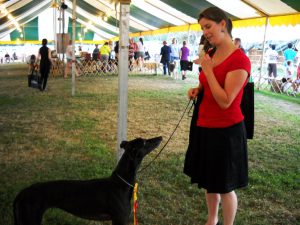Main Content

Consider this situation: It’s your first training session at your 4-H dog club meeting and you are excited to start teaching your dog basic obedience like “sit”. Your club leader demonstrates how to place your dog into the “sit” position. Everyone else easily puts their dog into a “sit” by replicating your leader’s instructions. You, on the other hand, have ended up in a wrestling match with your dog as they refuse to accept your directions. What’s going on? Why are the training techniques used by everyone else failing to work on your dog? Does this mean your dog cannot be trained?
If this situation sounded familiar, you’re not alone. Many handlers discover their training techniques do not match their dog’s learning style. This leads to frustration for both dog and handler. Training is not a one-size-fits-all situation. Each dog is unique in their personality and the way they approach problems. Some are happy-go-lucky and are eager to try new things without fear of failure. Other dogs give up easily when presented with even the simplest challenge.
For maximum training success, it is important to identify and understand your dog’s specific learning style and then tailor your training techniques to meet their needs. Some breeds are easy to identify because they are well-known for specific personality traits. For example, most Labrador Retrievers are eager to please and enjoy solving complex problems. Beagles, on the other hand, are easily distracted and lose interest in repetitive tasks. Not all dogs fall neatly into personality categories and are more often somewhere in between. It is the handler’s job to match their dog’s learning style with the training methods best suited for their dog’s individual needs.
Remember, training sessions should be a fun and positive experience for both dog and handler. Dogs look to you as their leader and learn best in an environment where they feel safe and relaxed. Set yourself up for success by keeping training sessions short and use positive techniques such as praise and treats. Never use techniques that create fear or inflict pain such as yelling and hitting. These methods can actually create or worsen bad behavior and breed a sense of distrust between you and your dog.
There are many resources available to help you discover the right training methods for your dog. Dogtime.com offers a detailed explanation of three common learning styles: highly sensitive, happy-go-lucky, and creative thinkers. After reading the descriptions, decide which one (or two) best describe your dog and consider ways to adjust your training methods to maximize learning. To learn more about the value of using positive training techniques, take a look at the American Kennel Club’s guide to using food rewards. This article will help you determine what your dog considers a “high value” reward and will work hard to earn.
By Kelly Dziak, 4-H Program Associate, Rutgers Cooperative Extension